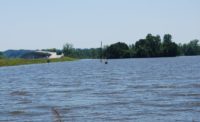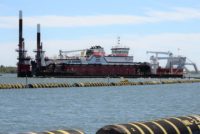Plans are moving ahead this week for two massive projects that would deliver 100-year flood protection for the lower Mississippi Valley. The question is whether the money and political will exists for the two protection systems to materialize.
One of the projects is the proposed $2 billion Upper Barataria levee system, which would provide 100-year storm surge protection for seven south Louisiana parishes and tie into the region’s overall storm protection system. The other project involves a $220 million pumping system that would be the last remaining feature in the Yazoo Backwater Project, which received congressional authorization in 1941 and has been moving forward piece by piece since then.
Given the historic flooding that has ravaged the South Delta for nearly every year of the last decade, the pumps project has been gaining federal and state support, and there’s growing optimism that the system could finally materialize.
“I think this is a good chance to finish off that project,” says Maj. Gen. (Ret.) Michael Walsh, a senior adviser with Dawson & Associates and formerly a deputy commanding general with the U.S. Army Corps of Engineers.
Both the pump and levee projects, Walsh says, would ultimately bode well for economic growth in the region. “We’ve seen over time when bonding agencies come into communities, before they set a price for their bonds, they ask ‘Do you have a resilience plan?’ he says. “And if not, bond companies are looking at it as a higher risk and maybe not going into that community for a bond.”
Ambitious new levee plans
Last month, the U.S. Army Corps of Engineers came forward with revised plans for the Upper Barataria levees system that would nearly double the elevation, span and years of protection outlined in the previous proposal.
The new plans, which the Corps issued Dec. 11, proposes a 30.6-mile levee system with an elevation of 14 ft between Luling and Raceland, offering protection to Ascension, Assumption, Jefferson, Lafourche, St. Charles, St. John and St. James parishes. Construction would begin in 2023 and conclude in 2026.
A tentatively selected plan for the project, released in November 2019, outlined a 50-year levee system that would span 18.3 miles with an elevation of 7.5 ft, coming in at a cost of $514 million.
“Once they got in and started designing and modeling the tentatively selected plan, it was realized that a bigger system was needed,” says Corps New Orleans spokesman Matt Roe.
Modeling of the study area provided new data the Corps used to develop and recalibrate its report to accommodate a 100-year system.
This week, the Corps has been holding virtual meetings to solicit public comments on the revised plans. The public review period ends Jan. 25. From there, the Corps’ New Orleans office will submit a final feasibility report to the Corps district office in March, and then for approval on the national level by October.
Securing funding for the multibillion-dollar project will be tricky, though, as the window for securing federal funding may still be two years off. “The project is likely going to need Congressional approval under the WRDA (Water Resources Development Act), and that’s going to take at least two years,” says Norma Jean Mattei, a member of the Mississippi River Commission and civil engineering professor at the University of New Orleans.
Congress votes on a WRDA bill every other year and just approved the most recent version of the legislation at the end of 2020.
80 years in the making
In Mississippi, there’s been growing support this week for the long-anticipated Yazoo Backwater Area Pumps Project.
On Monday, U.S. Environmental Protection Agency Administrator Andrew Wheeler visited Mississippi to sign a memorandum of understanding pledging to complete the Yazoo Backwater Area Pumps Project. In December 2020, the EPA indicated it does not object to a revised proposal for the project, even though the agency vetoed the pump system in 2008 because of its impact on thousands of acres of wetlands.
In December the Corps also reversed its previous opposition to the pumps, saying “These changes are not anticipated to convert any wetlands to non-wetlands, because precipitation is the driving force in sustaining wetlands in the Yazoo Study Area."
On Monday, the public comment period on a final draft of the Corps’ project plan ended. From there, the Corps’ Vicksburg office will submit a recommendation to the Corps’ Mississippi Valley Division, which will vote on the plan. The report would then go to Congress for approval and to secure funding.
The hope is that by moving the project forward, it will address the kind of severe flooding the region has experienced for nine of the past 10 years, says Kent Parrish, senior project manager with the Corps’ Vicksburg office. “The citizens have just been clamoring for help,” he says. “So they approached Congress asking if anything can be done.”
The last cost estimate for the project was for $220 million, but likely costs needed for the project have increased in the 14 years since the estimate was put together.
The significant, repeated flooding that’s devastated the region over the past decade could be what finally pushes the project to completion, Mattei says.
“We’ve had disastrous, high water situations, and Backwater has flooded for extended periods of time,” Mattei says. “Because of that, I think there’s a realization that the pumps should be a higher priority.”




